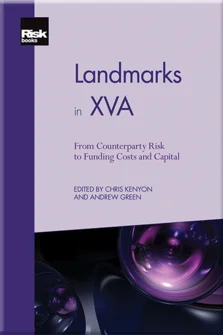An Annotated Bibliography of XVA
Hringur Gretarsson
An Annotated Bibliography of XVA
Introduction
Preface to Chapter 1
Being Two-Faced over Counterparty Credit Risk
Risky Funding: A Unified Framework for Counterparty and Liquidity Charges
DVA for Assets
Pricing CDSs’ Capital Relief
The FVA Debate
The FVA Debate: Reloaded
Regulatory Costs Break Risk Neutrality
Risk Neutrality Stays
Regulatory Costs Remain
Funding beyond Discounting: Collateral Agreements and Derivatives Pricing
Cooking with Collateral
Options for Collateral Options
Partial Differential Equation Representations of Derivatives with Bilateral Counterparty Risk and Funding Costs
In the Balance
Funding Strategies, Funding Costs
The Funding Invariance Principle
Regulatory-Optimal Funding
Close-Out Convention Tensions
Funding, Collateral and Hedging: Arbitrage-Free Pricing with Credit, Collateral and Funding Costs
Bilateral Counterparty Risk with Application to Credit Default Swaps
KVA: Capital Valuation Adjustment by Replication
From FVA to KVA: Including Cost of Capital in Derivatives Pricing
Warehousing Credit Risk: Pricing, Capital and Tax
MVA by Replication and Regression
Smoking Adjoints: Fast Evaluation of Monte Carlo Greeks
Adjoint Greeks Made Easy
Bounding Wrong-Way Risk in Measuring Counterparty Risk
Wrong-Way Risk the Right Way: Accounting for Joint Defaults in CVA
Backward Induction for Future Values
A Non-Linear PDE for XVA by Forward Monte Carlo
Efficient XVA Management: Pricing, Hedging and Allocation
Accounting for KVA under IFRS 13
FVA Accounting, Risk Management and Collateral Trading
Derivatives Funding, Netting and Accounting
Managing XVA in the Ring-Fenced Bank
XVA: A Banking Supervisory Perspective
An Annotated Bibliography of XVA
XVA is a relatively young field of research. Here we list papers related to the field and group them together into categories. The main category is counterparty credit risk (CCR), which contains several smaller categories that cover different CCR components. The other important category is discounting, which has a strong impact on pricing CCR.
Although the categories are all related, each component can be viewed as an independent research topic that still generates interesting research discussions.
COUNTERPARTY CREDIT RISK
Early research: CVA and DVA
One of the first papers on unilateral counterparty credit risk was by Johnson and Stulz (1987), who look at pricing options that are sold by firms that can default. This implies an adjustment to the credit risk-free price of the option (what was later called a credit valuation adjustment (CVA)).
Cooper and Mello (1991), Hull and White (1992, 1995), Abken (1993), Sorensen and Bollier (1994) and Jarrow and Turnbull (1995) take the theory further by modelling and quantifying the unilateral default risk of interest rate (IR) swaps. Duffie and Huang (1996) and Lotz and Schlögl (2000) value bilateral counterparty credit risk
Copyright Infopro Digital Limited. All rights reserved.
As outlined in our terms and conditions, https://www.infopro-digital.com/terms-and-conditions/subscriptions/ (point 2.4), printing is limited to a single copy.
If you would like to purchase additional rights please email info@risk.net
Copyright Infopro Digital Limited. All rights reserved.
You may share this content using our article tools. As outlined in our terms and conditions, https://www.infopro-digital.com/terms-and-conditions/subscriptions/ (clause 2.4), an Authorised User may only make one copy of the materials for their own personal use. You must also comply with the restrictions in clause 2.5.
If you would like to purchase additional rights please email info@risk.net











